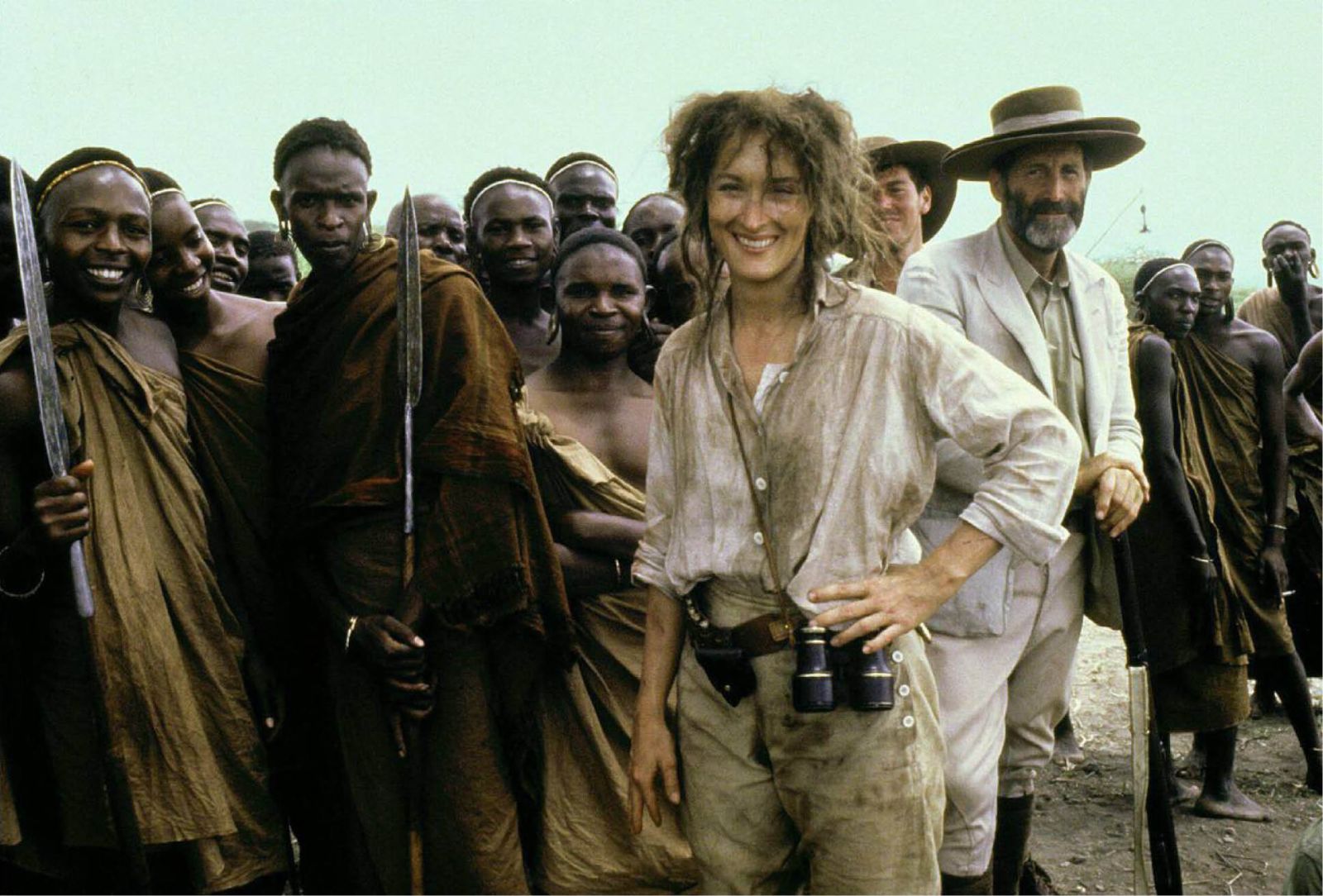The White Lady in Africa
By Hermione Hoby

White Material, dir. Claire Denis, 2009
The White Lady in Africa
Out of Africa and White Material traverse the same colonial territory in wildly different manners
By Hermione Hoby
March 13, 2023
Sydney Pollack’s blockbusting Out of Africa (1985) is an Academy Award–sweeping, escapist fantasia in which a version of Kenya unruffled by too much incommodious politics provides a swooningly scenic backdrop for romance. French independent film White Material (2009) is a barbed postcolonial nightmare culminating in homicidal violence, in which a loveless protagonist finds herself stuck between the rock and hard place of military force and rebel insurgents. The former is carried by a poised and piquant Meryl Streep as Karen Blixen, the Danish author who wrote under the nom de plume Isak Dinesen, whose 1937 memoir details her 17 years living in Kenya. The latter, directed by Claire Denis, stars Isabelle Huppert as a grubby, half-feral Maria Vial, a Frenchwoman who refuses to leave her land while the threat of civil war rumbles louder around her in an unnamed African country. White Material is one of Huppert’s best performances, Out of Africa one of Streep’s most famous. Both characters run coffee plantations. Both characters are urged by military officials to leave for reasons of safety. Both watch their respective plantations go up in flames. As with 2005’s The White Massai (Nina Hoss crushing on a Samburu warrior) or 2012’s Paradise: Love (Margarethe Tiesel as a sex tourist in Kenya), both can be crudely typified as “white lady in Africa” movies, an archetype less common in Western cinema than its male counterpart (Clark Gable’s 1924 breakout role in White Man, 1993’s Heart of Darkness, 1994’s parodic A Good Man in Africa, 2006’s Blood Diamond and so on). These are, however, two very different white ladies in two very different Africas.
From left: Out of Africa, dir. Sydney Pollack, 1985; Chocalat, dir. Claire Denis, 1988
Out of Africa opens in the Denmark of 1912, where a young Karen agrees to a marriage of convenience with Baron Bror Blixen, the brother of the lover who’s ditched her and a man keen to spend her money. The two decamp to the ravishingly beautiful Ngong Hills outside of Nairobi, where a world of polo ponies and cocktails prevails—an aesthetically lovely and politically rotten (an aspect unexamined by the movie) colonial milieu in which Black characters recede and the white leads are foregrounded against a series of unremittingly gorgeous vistas. Robert Redford plays the dashing Denys Finch Hatton, a big game hunter with his eye on Karen, who’s left alone to manage the coffee plantation when Blixen heads to the front. (History encroaches very little on this gilded pastorale, but even this postcard of a movie can’t quite dodge the First World War.) An officer arrives to tell Karen, “We’re going to have to move you into town, we can’t protect you here.” As his racist rationale goes: “With the men gone, we’re worried about the native element.” Plucky Karen stays put and prevails. Soon romance blooms: Adventuresome Denys coolly saves her from a lioness, woos her by procuring a gramophone with which to play Mozart to the baboons, takes her up in his biplane to better admire her land, and throughout all, his blond side-part remains immaculate. Karen and Denys seem to have an inordinate number of picnics. Life is a picnic, the movie whispers, so mellifluously you almost believe it. Watching it feels like falling asleep in public; I had the sensation of waking up embarrassed, wiping away drool, having been seduced and stupefied by a two-hour-and-forty-one-minute commercial for the great plains of East Africa and/or Robert Redford in riding boots.
In her odd, pontifical Danish accent, Streep intones the famous line “I had a farm in Africa” more than once—and no doubt continues to intone it in the memories of millions who saw the movie and succumbed to safari dreams. The line is telling in both its past tense and its possessive nature: This is a movie of shameless nostalgia and solipsism. The servants are “my Kikuyu,” the plantation is “my farm.” Drifting in full, elegant, white-savior mode through the village, Karen crouches to frown at a wound on a young boy’s leg and scolds him for not seeing a doctor. Soon he becomes another one of “her” servants: The film can only see her as benefactor, never oppressor. The closest we get to a fully formed Black character is the stalwart manservant Farah (Malick Bowens), whose purpose in the movie is the same as the continent’s itself—to serve Karen.

Meryl Streep as Karen Blixen in Out of Africa
“If I know a song of Africa,” Streep murmurs in twilit voice-over, “of the giraffe and the African new moon lying on her back, of the plows in the fields and the sweaty faces of the coffee pickers, does Africa know a song of me?” The answer to this very silly question is, of course, a plain nope. Why should it? Streep/Karen continues, as if tipsy on her own vainglorious poetastering: “Will the air over the plain quiver with a color that I have known? Or will the children invent a game on which my name is?” Speaking to The Washington Post upon the film’s release in 1985, historian Godfrey Muriuki, a dean at the University of Nairobi, remarked: “There is a significant group in Kenya of all walks of life who feel that a film like that should not be made at this juncture, because it tends to glorify the colonial period.” It might be truer to say the film not so much actively glorifies colonialism but rather makes it subservient to Karen and her romance. In this way Pollack’s movie suggests itself as a prototypical Eat Pray Love: The function of place is to provide a narcissistic white woman with adventure and erotic fulfillment.
No such subordination of reality exists within Denis’s scorching masterpiece. In the film, a radio DJ broadcasts a warning: “No more cocktails on shaded verandas while we sweat water and blood.” The phrase, at least its first half, so readily conjures Out of Africa’s unsweating world. White Material also features a self-absorbed white woman at its center, yet unlike Karen, Maria’s self-involvement proves fatal. Maniacally attached to her failing coffee plantation, she remains determined to harvest her crop of beans, even as her workers abandon ship and a military helicopter hovers overhead while issuing exhortations to evacuate. Control-freakery has blinded her to the political and racial reality of her situation. Most eloquent of all the film’s images is Maria hanging off the back of a bus in her flimsy cotton dress—it looks like a little girl’s—gripping the rail with ferocity, sinews of her skinny arms straining. She will not let go. There’s no room for her on the bus, whose passengers are all Black. The metaphor needn’t be over-labored.
“Whether Denis saw Pollack’s film, let alone intended White Material to be in conversation with that older work, it serves as Out of Africa’s savage refutation.”
The film’s most disturbing moment, however, comes via Maria’s layabout adult son, Manuel (Nicolas Duvauchelle). Turned cracked and demonic by, so the implication goes, the schizoid situation of being a white kid born into this Black world, he shaves off his blond hair and then stuffs a fistful of his shorn locks in the mouth of a young Black woman working in the house. I thought of Redford’s equally lovely blond hair, forever unruffled in the ahistorical dream of Out of Africa. When Karen’s plantation burns—an accident! A character-building trial for our heroine!—she crouches beside a small Black child, arm around him, and watches mistily. When Maria’s finally goes up in flames, it’s arson, no accident, and there are no docile children to be enlisted in a matrician embrace, because most of the movie’s kids are soldiers and Maria, their enemy. There’s only, ultimately, the hideously charred and unrecognizable corpse of her son.
French-Senegalese novelist Marie NDiaye co-wrote the original script with Denis and was asked about the film in an interview with British literary journal The White Review. Did NDiaye herself lay any claim to African culture? The writer, who grew up in the suburbs of Paris, responded: “No, that’s out of the question for me, it would make me feel like a total impostor.” She added that in French “the word impostor has no feminine form, perhaps because to be one, you need to have the power to make decisions about your own life.” The biting implication—that imposter status is a fucked-up privilege essentially denied women due to their lack of agency—raises the question of whether Maria has the power to make decisions about her own life. White Material is fascinatingly ambiguous on this point, keeping its main character in fraught oscillation between determined self-possession and pathetic, vulnerable delusion. When a worker asks the diminutive Maria whether she’s the boss, she replies, “Nothing’s mine, but I’m in charge.” Her ailing father-in-law owns the land; what she doesn’t know is that her ex-husband is selling it out from under her. The biggest problem, however, is her failure to see herself through the eyes of the rebels—as a white oppressor. In other words she is both imposter and so much less in charge than she thinks.
From left: Cécile Ducasse, Isaach De Bankolé and Giulia Boschi in Chocolat; Isabelle Huppert in White Material
A softer term than imposter is tourist. Softer but perhaps no less damning: To be a tourist is to live for your own pleasure, with merely a dilettantish, gustatory engagement with your environment. (Picnicking and condescending to the natives, for example.) Denis grew up in several French-administered African countries, including Cameroon, where she filmed both White Material and her debut, 1988’s Chocolat. She’s not, in other words, a tourist. Chocolat’s main character is Protée, a servant in a white household. He’s played by the magnificent Isaach De Bankolé, who also plays Le Boxeur in White Material, the leader of a band of child soldiers. The full, nuanced character of Protée provides a corrective of sorts to Out of Africa’s two-dimensional manservant Farah. Similarly, whether Denis saw Pollack’s film, let alone intended White Material to be in conversation with that older work, it serves as Out of Africa’s savage refutation.
I was a teenager when I went to South Africa for the first time. My dad had left the country in the ’70s, after being told his anti-apartheid activism would get him “accidentally” shot. He’d once returned to his apartment to find it ransacked. He’d tried, with unsurprising lack of success, to join the African National Congress—unsurprising in that the party was no doubt wary of white informants. The year I visited was 1998, but I felt I’d landed in 1950s America: The women deferred and baked; the men dominated and barbecued. The various white relations we stayed with all had Black servants whom they talked to like children. In the kitchen of one of these relations, my mum made a bitter allusion to the racist adage of “their all looking the same.” Our hostess turned to my mother, brightening, as if suddenly grasping a thread of connection with this strange British woman, and said: “Ah, yes! Do you think so too?” Before the fictional Karen and Maria, this real woman—in her floral dress, misbegotten contentment and moral obliviousness—is the White Lady in Africa I think of. But then again, I was nothing but a tourist in that place.





